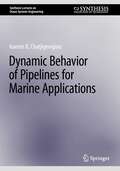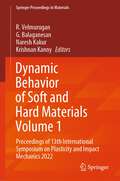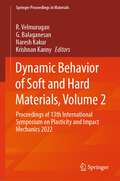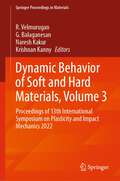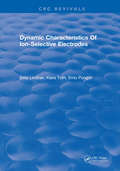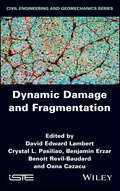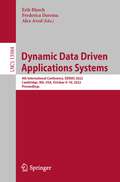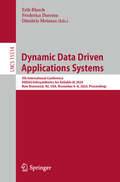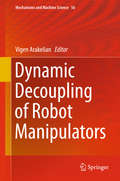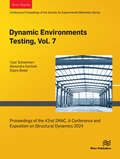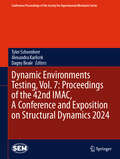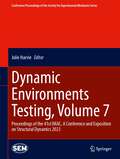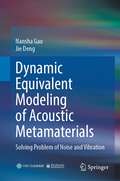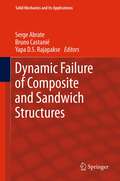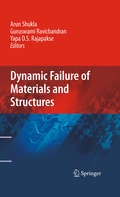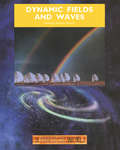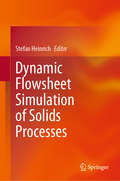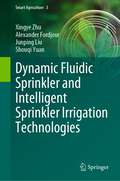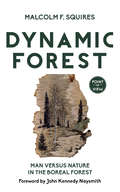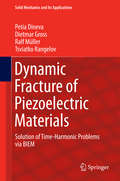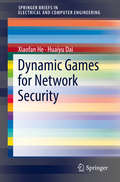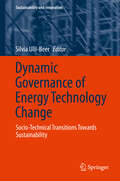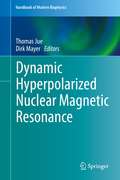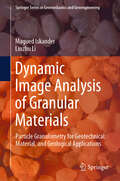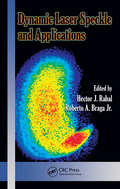- Table View
- List View
Dynamic Behavior of Pipelines for Marine Applications (Synthesis Lectures on Ocean Systems Engineering)
by Ioannis K. ChatjigeorgiouThe dynamic behavior of pipelines describes the time-varying continuous response of these structures under extreme effects, that are generated by the surrounding environment (waves and sea currents) and motions imposed by the host floating facility. This book describes all known impacts that affect the behavior and operation of a pipeline conveying an inner flow for underwater applications. "Known Impacts" are those phenomena that are considered important according to practice and experience. Underwater pipelines are typical, unique structures that are attached to unique floating facilities. The design and utilization of underwater pipelines depend strongly on the installation site and the intended application's particulars. It is possible that future technology demands will require us to cope with additional challenges that will be considered important for the design and operation of underwater pipelines, leading inevitably to the enhancement of the "known challenges".
Dynamic Behavior of Soft and Hard Materials Volume 1: Proceedings of 13th International Symposium on Plasticity and Impact Mechanics 2022 (Springer Proceedings in Materials #34)
by Krishnan Kanny R. Velmurugan G. Balaganesan Naresh KakurThis book comprises the select peer-reviewed proceedings of the 13th International Symposium on Plasticity and Impact Mechanics (IMPLAST) 2022, which was held at Indian Institute of Technology, Madras, to commemorate the 80th birthday of Prof. N K Gupta, IIT, Delhi. It aims to provide a comprehensive and broad-spectrum picture of the state-of-the-art research and development in diverse areas, such as constitutive relations, theories of plasticity, stress waves in solids, earthquake loading, high-speed impact problems, fire and blast loading, structural crashworthiness and failure, mechanics of penetration and perforation, among others. The contents focus on aspects of large deformations and failure of materials, including metals, composites, cellular, geomaterials, or concrete, and structures resulting from quasi-static earthquake, fire, impact, or blast loading. This book is a valuable resource for researchers and professionals working in academia and industry in the areas of mechanical, materials, and aerospace engineering.
Dynamic Behavior of Soft and Hard Materials, Volume 2: Proceedings of 13th International Symposium on Plasticity and Impact Mechanics 2022 (Springer Proceedings in Materials #35)
by Krishnan Kanny R. Velmurugan G. Balaganesan Naresh KakurThis book comprises the select peer-reviewed proceedings of the 13th International Symposium on Plasticity and Impact Mechanics (IMPLAST) 2022. It aims to provide a comprehensive and broad-spectrum picture of the state-of-the-art research and development in diverse areas, such as constitutive relations, theories of plasticity, stress waves in solids, earthquake loading, high-speed impact problems, fire and blast loading, structural crashworthiness and failure, mechanics of penetration and perforation, among others. The contents focus on aspects of large deformations and failure of materials, including metals, composites, cellular, geomaterials, or concrete, and structures resulting from quasi-static earthquake, fire, impact, or blast loading. This book is a valuable resource for researchers and professionals working in academia and industry in the areas of mechanical, materials, and aerospace engineering.
Dynamic Behavior of Soft and Hard Materials, Volume 3: Proceedings of 13th International Symposium on Plasticity and Impact Mechanics 2022 (Springer Proceedings in Materials #36)
by Krishnan Kanny R. Velmurugan G. Balaganesan Naresh KakurThis book comprises the select peer-reviewed proceedings of the 13th International Symposium on Plasticity and Impact Mechanics (IMPLAST) 2022. It aims to provide a comprehensive and broad-spectrum picture of the state-of-the-art research and development in diverse areas, such as constitutive relations, theories of plasticity, stress waves in solids, earthquake loading, high-speed impact problems, fire and blast loading, structural crashworthiness and failure, mechanics of penetration and perforation, among others. The contents focus on aspects of large deformations and failure of materials, including metals, composites, cellular, geomaterials, or concrete, and structures resulting from quasi-static earthquake, fire, impact, or blast loading. This book is a valuable resource for researchers and professionals working in academia and industry in the areas of mechanical, materials, and aerospace engineering.
Dynamic Characteristics Of Ion Selective Electrodes
by Erno LindnerThe present book deals with the principle of the aforementioned techniques and discusses the information they provide for electrode kinetics. Special attention is paid to the activity step method, since this technique is carried out under zero current potentiometric conditions and allows the study of the processes at the perturbed membrane-solution interface.
Dynamic Damage and Fragmentation
by Oana Cazacu Benoit Revil-Baudard David Edward Lambert Crystal L. Pasiliao Benjamin ErzarEngineering structures may be subjected to extreme high-rate loading conditions, like those associated with natural disasters (earthquakes, tsunamis, rock falls, etc.) or those of anthropic origin (impacts, fluid–structure interactions, shock wave transmissions, etc.). Characterization and modeling of the mechanical behavior of materials under these environments is important in predicting the response of structures and improving designs. This book gathers contributions by eminent researchers in academia and government research laboratories on the latest advances in the understanding of the dynamic process of damage, cracking and fragmentation. It allows the reader to develop an understanding of the key features of the dynamic mechanical behavior of brittle (e.g. granular and cementitious), heterogeneous (e.g. energetic) and ductile (e.g. metallic) materials.
Dynamic Data Driven Applications Systems: 4th International Conference, DDDAS 2022, Cambridge, MA, USA, October 6–10, 2022, Proceedings (Lecture Notes in Computer Science #13984)
by Erik Blasch Alex Aved Frederica DaremaThis book constitutes the refereed proceedings of the 4th International Conference on Dynamic Data Driven Applications Systems, DDDAS 2022, which took place in Cambridge, MA, USA, during October 6–10, 2022.The 31 regular papers in the main track and 5 regular papers from the Wildfires panel, as well as one workshop paper, were carefully reviewed and selected for inclusion in the book. They were organized in following topical sections: DDAS2022 Main-Track Plenary Presentations; Keynotes; DDDAS2022 Main-Track: Wildfires Panel; Workshop on Climate, Life, Earth, Planets.
Dynamic Data Driven Applications Systems: 5th International Conference, DDDAS/Infosymbiotics for Reliable AI 2024, New Brunswick, NJ, USA, November 6–8, 2024, Proceedings (Lecture Notes in Computer Science #15514)
by Dimitris Metaxas Erik Blasch Frederica DaremaThis book constitutes the refereed proceedings of the 5th International Conference on Dynamic Data Driven Applications Systems, DDDAS/Infosymbiotics for Reliable AI 2024, held in New Brunswick, NJ, USA, during November 6–8, 2024. The 43 full papers included in this book were carefully reviewed and selected from 52 submissions. By combining DDDAS and typical AI approaches, the papers address state-of-the-art efforts to create frameworks for enabling new and advanced Science and Technology capabilities to address challenges and create opportunities in important areas, spanning a wide set of areas, such as: materials and aerospace systems; communications networks; energy infrastructures; cyber-security; adverse environmental situations; societal dynamics; computer vision; robotics; laboratory automation; bio-informatics and pharmaceuticals design; and more.
Dynamic Decoupling of Robot Manipulators
by Vigen ArakelianThis book presents the latest results in the field of dynamic decoupling of robot manipulators obtained in France, Russia, China and Austria.Manipulator dynamics can be highly coupled and nonlinear. The complicated dynamics result from varying inertia, interactions between the different joints, and nonlinear forces such as Coriolis and centrifugal forces. The dynamic decoupling of robot manipulators allows one to obtain a linear system, i.e. single-input and single output system with constant parameters. This simplifies the optimal control and accumulation of energy in manipulators. There are two ways to create the dynamically decoupled manipulators: via optimal mechanical design or control.This work emphasises mechatronic solutions. These will certainly improve the known design concepts permitting the dynamic decoupling of serial manipulators with a relatively small increase in total mass of the moving links taking into account the changing payload. For the first time such an approach has been applied on serial manipulators. Also of great interest is the dynamic decoupling control of parallel manipulators. Firstly, the dynamic model of redundant multi-axial vibration table with load has been established, and, secondly, its dynamic coupling characteristics have been analyzed. The discussed methods and applications of dynamic decoupling of robot manipulators are illustrated via CAD simulations and experimental tests.
Dynamic Environments Testing, Vol. 7: Proceedings of the 42nd IMAC, A Conference and Exposition on Structural Dynamics 2024
by Tyler Schoenherr Alexandra Karlicek Dagny BealeDynamic Environments Testing, Volume 7: Proceedings of the 42nd IMAC, A Conference and Exposition on Structural Dynamics, 2024, the seventh volume of ten from the Conference brings together contributions to this important area of research and engineering. The collection presents early findings and case studies on fundamental and applied aspects Dynamic Environments Testing including papers on: Dynamic Environment Definition and Specification Dynamic Testing Fixture Design Single Axis Shaker Testing Multi-Degree of Freedom Shaker Testing Transient Testing.
Dynamic Environments Testing, Vol. 7: Proceedings of the 42nd IMAC, A Conference and Exposition on Structural Dynamics 2024 (Conference Proceedings of the Society for Experimental Mechanics Series)
by Tyler Schoenherr Alexandra Karlicek Dagny BealeDynamic Environments Testing, Volume 7: Proceedings of the 42nd IMAC, A Conference and Exposition on Structural Dynamics, 2024, the seventh volume of ten from the Conference brings together contributions to this important area of research and engineering. The collection presents early findings and case studies on fundamental and applied aspects Dynamic Environments Testing including papers on: Dynamic Environment Definition and Specification Dynamic Testing Fixture Design Single Axis Shaker Testing Multi-Degree of Freedom Shaker Testing Transient Testing
Dynamic Environments Testing, Volume 7: Proceedings of the 41st IMAC, A Conference and Exposition on Structural Dynamics 2023 (Conference Proceedings of the Society for Experimental Mechanics Series)
by Julie HarvieDynamic Environments Testing, Volume 7: Proceedings of the 41st IMAC, A Conference and Exposition on Structural Dynamics, 2023, the seventh volume of ten from the Conference brings together contributions to this important area of research and engineering. The collection presents early findings and case studies on fundamental and applied aspects Dynamic Environments Testing including papers on:Vibration Testing Shock TestingMulti-Axis Shaker Testing Test Fixture Design Dynamic Environment Definition Specifications for Acceptance Testing
Dynamic Equivalent Modeling of Acoustic Metamaterials: Solving Problem of Noise and Vibration
by Nansha Gao Jie DengThis book derives physical models from basic principles, studies the effect of equivalent models on the dynamic characteristics of phononic crystals and acoustic metamaterials, and analyzes the physical mechanisms behind vibration and noise reduction. It first summarizes the research status of vibration and noise reduction, and research progress in phononic crystals and acoustic metamaterials. Based on this, one-dimensional periodic beam, two-dimensional thin plate with circular hole, and corresponding gradient structures are introduced, and their dynamic characteristics are discussed in detail. Therefore, different equivalent methods for different models are proposed through theoretical analysis, modal analysis and transmission rate analysis. Finally, a Helmholtz-type acoustic metamaterial, i.e. a multi-layer slotted tube acoustic metamaterial, is studied. Aiming at the low-frequency band gap of this model, a theoretical model for solving the inverse problem of acousto-electric analogue equivalent is proposed, and the effect of structural parameters on the low-frequency band gap is studied using this equivalent model. This book closely revolves around how to conduct equivalent research on artificially fabricated periodic structures. The methods and conclusions presented in this book provide a new theoretical basis for the application of artificial woven periodic structures in the field of low-frequency vibration reduction and noise reduction and are also an innovation in the discipline of vibration and noise control. This book is suitable for undergraduate students, graduate students and teachers in vibration and noise majors in universities, and can also provide references for engineering and technical personnel in related fields.
Dynamic Failure of Composite and Sandwich Structures
by Bruno Castanié Serge Abrate Yapa D. RajapakseThis book presents a broad view of the current state of the art regarding the dynamic response of composite and sandwich structures subjected to impacts and explosions. Each chapter combines a thorough assessment of the literature with original contributions made by the authors. The first section deals with fluid-structure interactions in marine structures. The first chapter focuses on hull slamming and particularly cases in which the deformation of the structure affects the motion of the fluid during the water entry of flexible hulls. Chapter 2 presents an extensive series of tests underwater and in the air to determine the effects of explosions on composite and sandwich structures. Full-scale structures were subjected to significant explosive charges, and such results are extremely rare in the open literature. Chapter 3 describes a simple geometrical theory of diffraction for describing the interaction of an underwater blast wave with submerged structures. The second section addresses the problem of impact on laminated composite structures with chapters devoted to ballistic impacts on pre-stressed composite structures, tests developed to simulate dynamic failure in marine structures, damage mechanisms and energy absorption in low velocity impacts, perforation, the numerical simulation of intra and inter-ply damage during impact, and hail impact on laminated composites. Sandwich structures with laminated facings are considered in Section 3 with chapters dealing with the discrete modeling of honeycomb core during the indentation of sandwich structures, the behavior of fold core sandwich structures during impact, and impact on helicopter blades. The fourth section consists of two chapters presenting experimental results and numerical simulation of composite structures subjected to crash. This volume is intended for advanced undergraduate and graduate students, researchers, and engineers interested and involved in analysis and design of composite structures.
Dynamic Failure of Materials and Structures
by Arun Shukla Yapa D.S. Rajapakse Guruswami RavichandranDynamic Failure of Materials and Structures discusses the topic of dynamic loadings and their effect on material and structural failure. Since dynamic loading problems are very difficult as compared to their static counterpart, very little information is currently available about dynamic behavior of materials and structures. Topics covered include the response of both metallic as well as polymeric composite materials to blast loading and shock loadings, impact loadings and failure of novel materials under more controlled dynamic loads. These include response of soft materials that are important in practical use but have very limited information available on their dynamic response. Dynamic fragmentation, which has re-emerged in recent years has also been included. Both experimental as well as numerical aspects of material and structural response to dynamic loads are discussed. Written by several key experts in the field, Dynamic Failure of Materials and Structures will appeal to graduate students and researchers studying dynamic loadings within mechanical and civil engineering, as well as in physics and materials science.
Dynamic Fields and Waves
by A. NortonThis book explores the use of waves on strings and sound waves to illustrate the behaviour of waves. It shows how Albert Einstein overturned Newtonian physics and predicted startling new effects such as time dilation and length contraction for objects travelling at close to the speed of light.
Dynamic Flowsheet Simulation of Solids Processes
by Stefan HeinrichThis book presents the latest advances in flowsheet simulation of solids processes, focusing on the dynamic behaviour of systems with interconnected solids processing units, but also covering stationary simulation. The book includes the modelling of solids processing units, for example for comminution, sifting and particle formulation and also for reaction systems. Furthermore, it examines new approaches for the description of solids and their property distributions and for the mathematical treatment of flowsheets with multivariate population balances.
Dynamic Fluidic Sprinkler and Intelligent Sprinkler Irrigation Technologies (Smart Agriculture #3)
by Junping Liu Xingye Zhu Alexander Fordjour Shouqi YuanThis book presents a newly designed dynamic fluidic sprinkler (DFS) to improve hydraulic performance of the existing complete fluidic sprinkler (CFS) under low-pressure conditions. Sprinkler irrigation has high prospects for improving water management in crop production. In recent years, low-pressure water-saving has become an important research content in the field of sprinkler irrigation. It introduces the effect of riser height on rotation uniformity and application rate of the dynamic fluidic sprinkler. It also discusses the intelligent sprinkler irrigation technologies for autonomous and remote sensing system. This book will be a useful reference for researchers and professionals in the field of agriculture and irrigation.
Dynamic Forest: Man Versus Nature in the Boreal Forest
by Malcolm F. Squires Dr John Kennedy NaysmithNearing the end of a lifetime in the boreal forest, a retired forester writes a passionate plea for rational, science-based forest management. The boreal forest is constantly changing, often dramatically. We like to picture it as a stable, balanced system. Really, it is anything but stable. The boreal forest is dynamic. For over sixty years, forester Malcolm F. Squires has seen mature forests within protected areas devastated by insects, moose, wind, and wildfire. While the forests often return from this destruction, they are never quite the same. A naturally balanced boreal forest is a human notion that does not match the reality of nature. If we don’t soon recognize and accept that reality and stop making irrational demands that a forest be “protected” from change or human management, we may be dooming them to disaster.
Dynamic Fracture of Piezoelectric Materials
by Petia Dineva Dietmar Gross Ralf Müller Tsviatko RangelovDynamic Fracture of Piezoelectric Materials focuses on the Boundary Integral Equation Method as an efficient computational tool. The presentation of the theoretical basis of piezoelectricity is followed by sections on fundamental solutions and the numerical realization of the boundary value problems. Two major parts of the book are devoted to the solution of problems in homogeneous and inhomogeneous solids. The book includes contributions on coupled electro-mechanical models, computational methods, its validation and the simulation results, which reveal different effects useful for engineering design and practice. The book is self-contained and well-illustrated, and it serves as a graduate-level textbook or as extra reading material for students and researchers.
Dynamic Games for Network Security (Springerbriefs In Electrical And Computer Engineering)
by Xiaofan He Huaiyu DaiThe goal of this SpringerBrief is to collect and systematically present the state-of-the-art in this research field and the underlying game-theoretic and learning tools to the broader audience with general network security and engineering backgrounds. Particularly, the exposition of this book begins with a brief introduction of relevant background knowledge in Chapter 1, followed by a review of existing applications of SG in addressing various dynamic network security problems in Chapter 2. A detailed treatment of dynamic security games with information asymmetry is given in Chapters 3–5. Specifically, dynamic security games with extra information that concerns security competitions, where the defender has an informational advantage over the adversary are discussed in Chapter 3. The complementary scenarios where the defender lacks information about the adversary is examined in Chapter 4 through the lens of incomplete information SG. Chapter 5 is devoted to the exploration of how to proactively create information asymmetry for the defender’s benefit.The primary audience for this brief includes network engineers interested in security decision-making in dynamic network security problems. Researchers interested in the state-of-the-art research on stochastic game theory and its applications in network security will be interested in this SpringerBrief as well. Also graduate and undergraduate students interested in obtaining comprehensive information on stochastic game theory and applying it to address relevant research problems can use this SpringerBrief as a study guide. Lastly, concluding remarks and our perspective for future works are presented in Chapter 6.
Dynamic Governance of Energy Technology Change
by Silvia Ulli-BeerFormulating effective responses to the global challenges of mitigating climate change and securing a sustainable energy future requires a clear understanding of the interdependent causalities between institutions, local decision making, strategic alliances and eco-innovations, as well as policies. It has been acknowledged that the linear "Manhattan project" model is not an adequate governance model for mastering the dynamic complexity of socio-technical transitions; therefore this book aims at advancing research on systematic transition management models. It offers qualitative and quantitative analyses of socio-technical transitions in road transportation and housing, bringing together tailored theorizing on sustainability transitions and applied system dynamics modeling. It highlights the interconnected causal feedbacks that are required to overcome the lock-in situation in road transportation and housing fueled by fossil energies. Showing which concerted actions and framework conditions are required in the transition phases in order to initiate and sustain socio-technical transition, it serves as a guide to model-based strategy making, policy design and analyses in support of sustainable futures.
Dynamic Hyperpolarized Nuclear Magnetic Resonance (Handbook of Modern Biophysics)
by Thomas Jue Dirk MayerThis is the first book in the series to focus on dynamic hyperpolarized nuclear magnetic resonance, a burgeoning topic in biophysics. The volume follows the format and style of the Handbook of Modern Biophysics series and expands on topics already discussed in previous volumes. It builds a theoretical and experimental framework for students and researchers who wish to investigate the biophysics and biomedical application of dynamic hyperpolarized NMR. All contributors are internationally recognized experts, lead the dynamic hyperpolarized NMR field, and have first-hand knowledge of the chapter material. The book covers the following topics: Hyperpolarization by dissolution Dynamic Nuclear Polarization Design considerations for implementing a hyperpolarizer Chemical Shift Imaging with Dynamic Hyperpolarized NMR Signal Sampling Strategies in Dynamic Hyperpolarized NMRKinetic Modeling of Enzymatic Reactions in Analyzing Hyperpolarized NMR DataUsing Hyperpolarized NMR to Understand Biochemistry from Cells to Humans Innovating Metabolic Biomarkers for Hyperpolarized NMR New Insights into Metabolic Regulation from Hyperpolarized 13C MRS/MRI Studies Novel Views on Heart Function from Dynamic Hyperpolarized NMR Insights on Lactate Metabolism in Skeletal Muscle based on 13C Dynamic Nuclear Polarization Studies About the Editors Dirk Mayer is Professor of Diagnostic Radiology and Nuclear Medicine at the University of Maryland and is the Director of Metabolic Imaging. He is a recognized expert on dynamic nuclear polarization (DNP) MRI-based imaging techniques and has optimized acquisition and reconstruction techniques, has constructed kinetic modeling for quantitative analysis, and has developing new probes. Thomas Jue is Professor of Biochemistry and Molecular Medicine at the University of California Davis. He is an internationally recognized expert in developing and applying magnetic resonance techniques to study animal as well as human physiology in vivo. He served as a Chair of the Biophysics Graduate Group Program at UC Davis, where he started to redesign a graduate curriculum that balances physical science/mathematics formalism and biomedical perspective in order to promote interest at the interface of physical science, engineering, mathematics, biology, and medicine. The Handbook of Modern Biophysics represents an aspect of that effort.
Dynamic Image Analysis of Granular Materials: Particle Granulometry for Geotechnical, Material, and Geological Applications (Springer Series in Geomechanics and Geoengineering)
by Magued Iskander Linzhu LiThis book explores the effectiveness of Dynamic Image Analysis (DIA) in granulometry studies of sand, and presents criteria for soil characterization using DIA, including test parameters, specimen size, efficacy in gap-graded soils, and its limitations. DIA is a modern experimental technique used to analyze and classify particulate materials based on their size, shape, and other morphological properties. This method employs a high-frame-rate camera to capture images of individual sand particles, which have been transported and separated using various techniques. DIA generates both particle size and shape information by analyzing thousands to millions of particles, providing a quantitative statistical description of grain size and shape distribution within the specimen. The manuscript also offers a comprehensive examination of 2D and 3D particle size and shape descriptors. It demonstrates that there is no correlation between size and shape parameters in many sands and that shape descriptors can be reduced to four independent parameters representing sand granulometry at different scales. Additionally, the use of DIA in exploring the depositional history of two complex calcareous sands is presented. The manuscript presents the properties of 30 representative sands, including size and shape parameters, and fits them to statistical distributions. The investigated soils encompass both natural and machine-sorted materials, particles with regular and irregular shapes, as well as siliceous and calcareous sands. Physical granulometry of sand particles is compared using 2D, 3D DIA, and micro-computed tomography (μCT). The work demonstrates that DIA offers significant advantages in terms of efficiency for 3D shape analysis while providing an adequate representation of particle sizes and shapes of most sands. Finally, the manuscript integrates classical geotechnical engineering with computer vision and artificial intelligence. Size and shape descriptors are utilized for sand classification through machine learning models. This work represents a crucial step toward the automatic machine classification of soils, potentially enabling on-site classification using smartphones equipped with high-resolution cameras.
Dynamic Laser Speckle and Applications (Optical Science and Engineering)
by Hector J. Rabal and Roberto A. BragaSpeckle study constitutes a multidisciplinary area with inherent complexities. In order to conquer challenges such as the variability of samples and sensitive measurements, researchers must develop a theoretical and statistical understanding of both biological and non-biological metrology using dynamic speckle laser.Dynamic Laser Speckle and Applications discusses the main methodologies used to analyze biospeckle phenomena with a strong focus on experimentation. After establishing a theoretical background in both speckle and biospeckle, the book presents the main methodologies for statistical and image analysis. It then deals with the concept of frequency decomposition before moving on to a discussion of fuzzy methods to treat dynamic speckle data. The book dedicates two sections to applications, including agricultural approaches. Additional features include photo images of experiments and software to aid in easy start-up of dynamic speckle usage.A systematic approach to new dynamic speckle laser phenomena, this book provides the physical theory and statistical background needed to analyze images formed by laser illumination in biological and non-biological samples.
